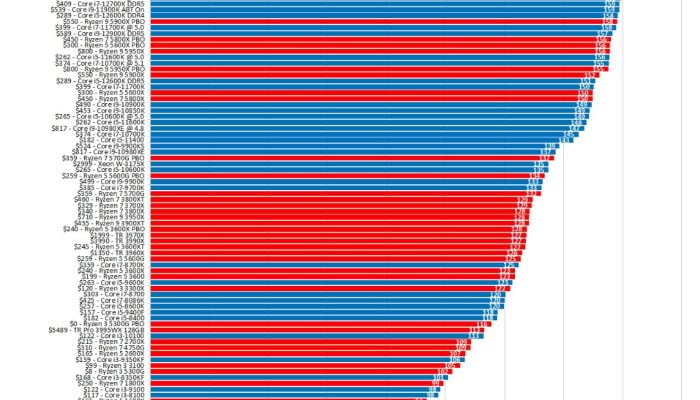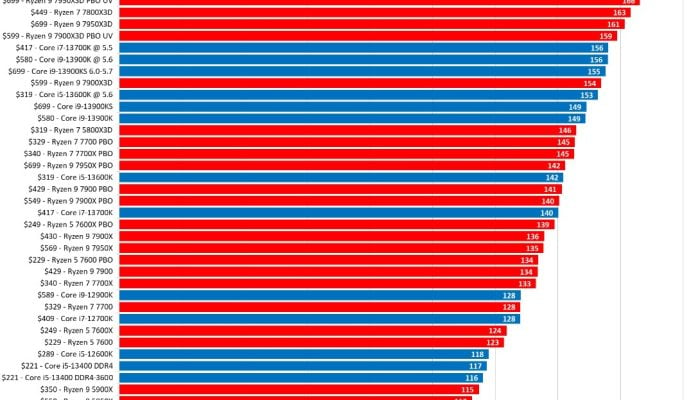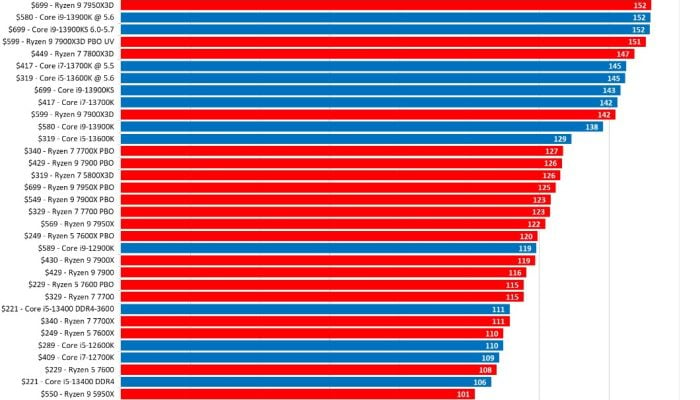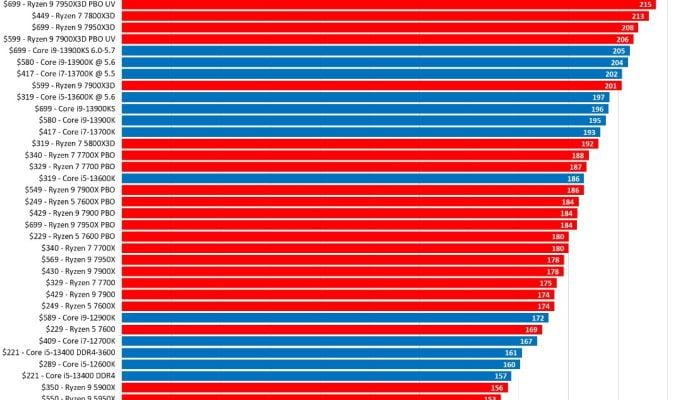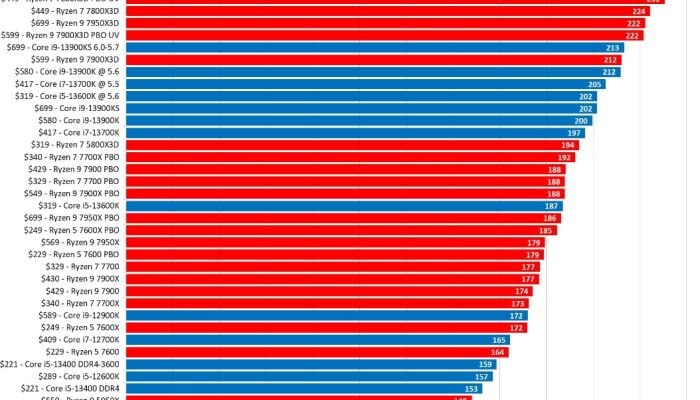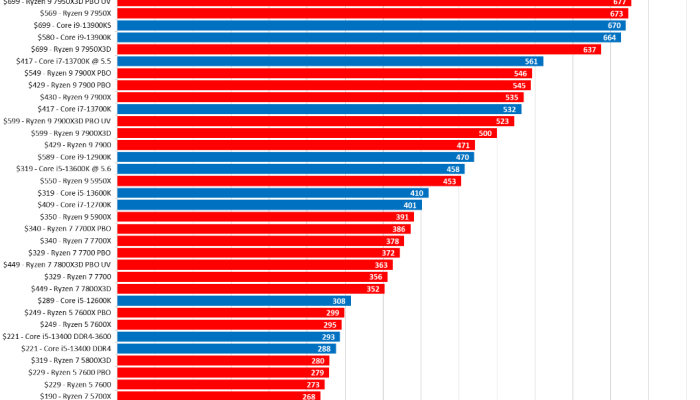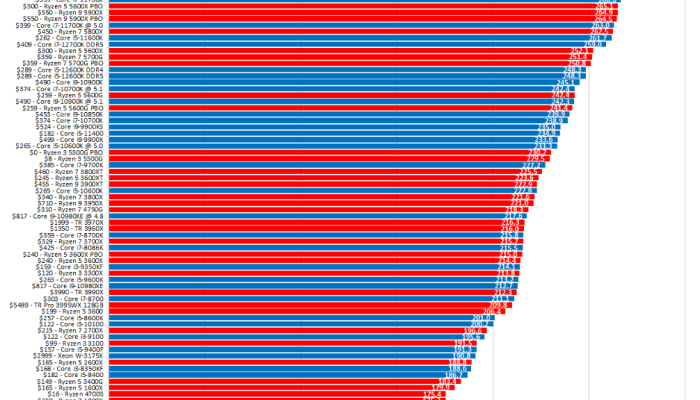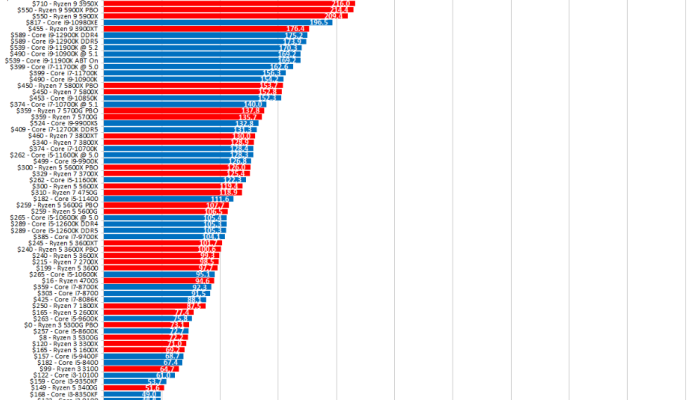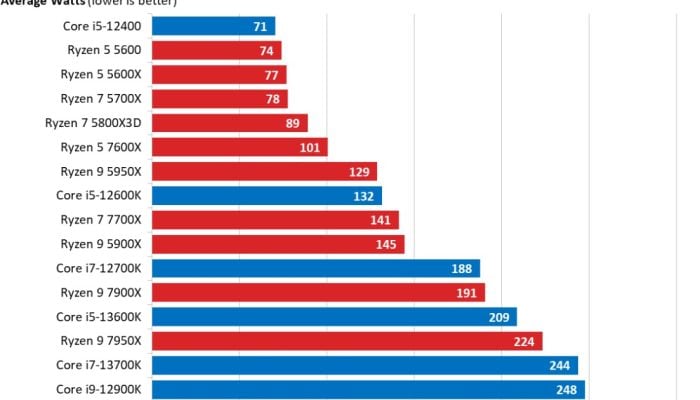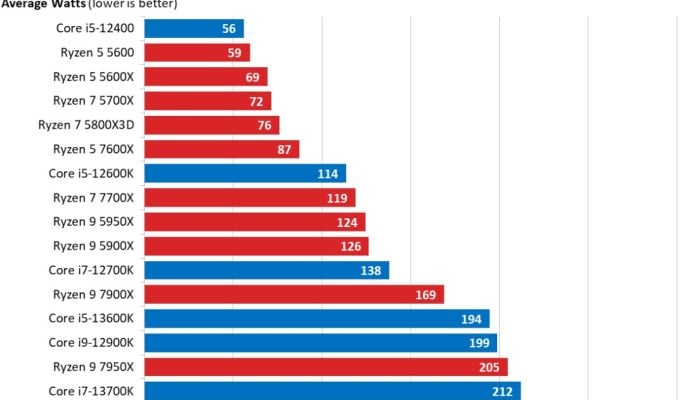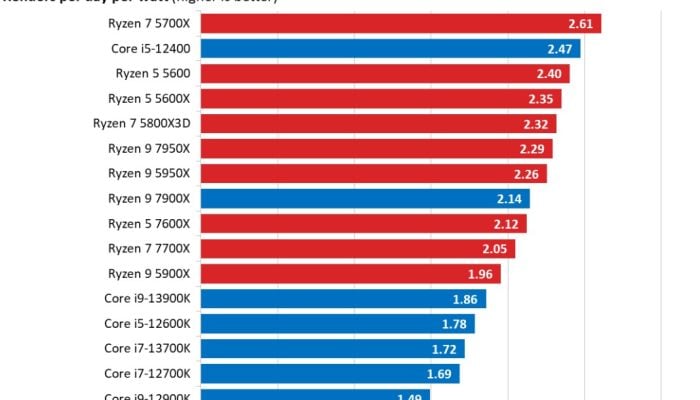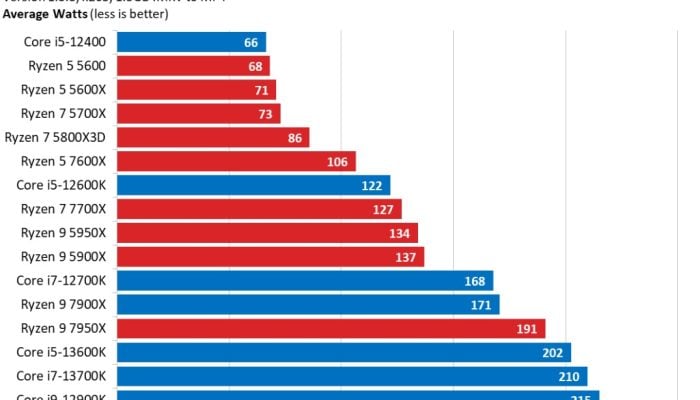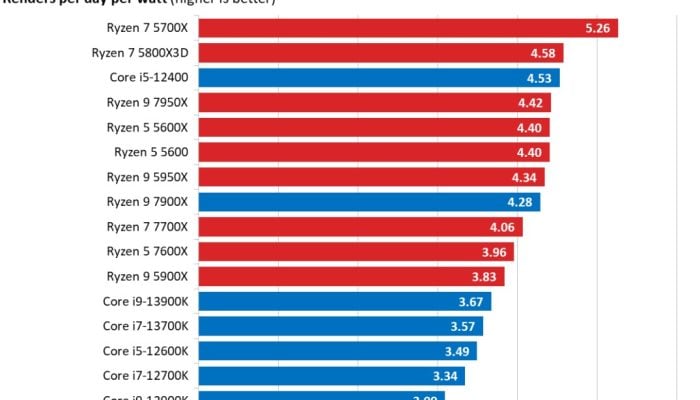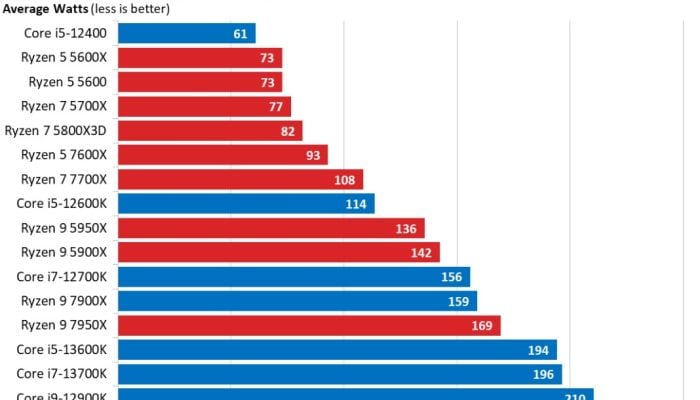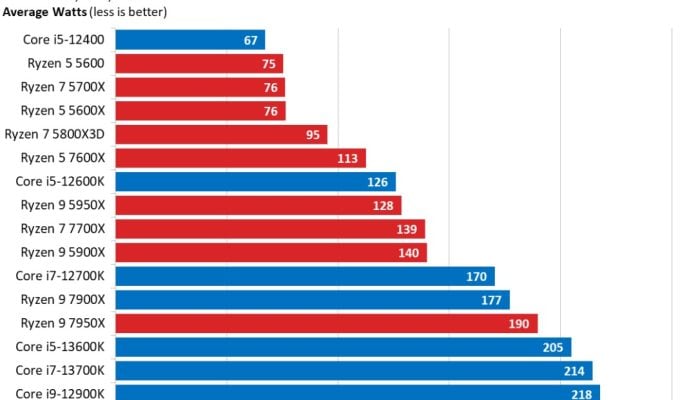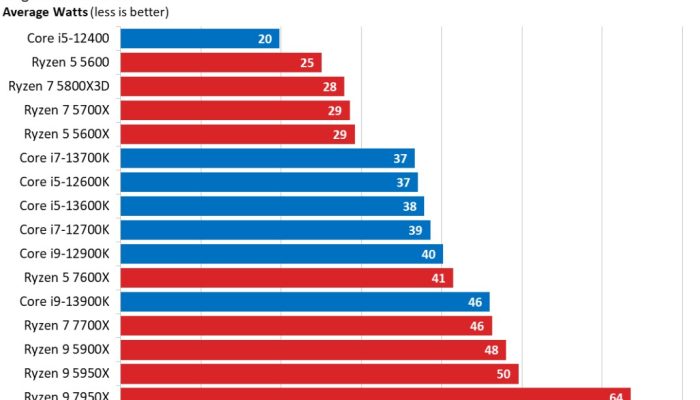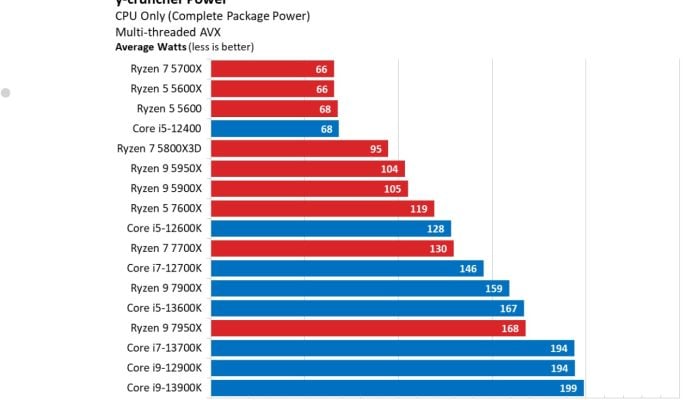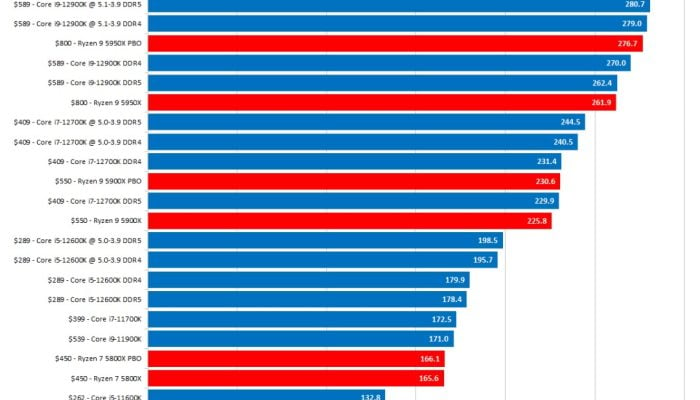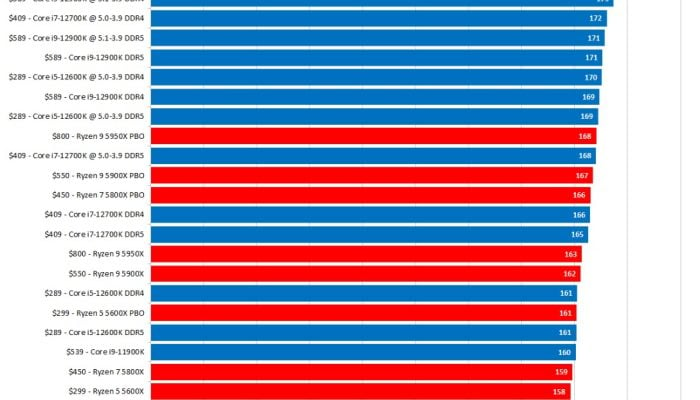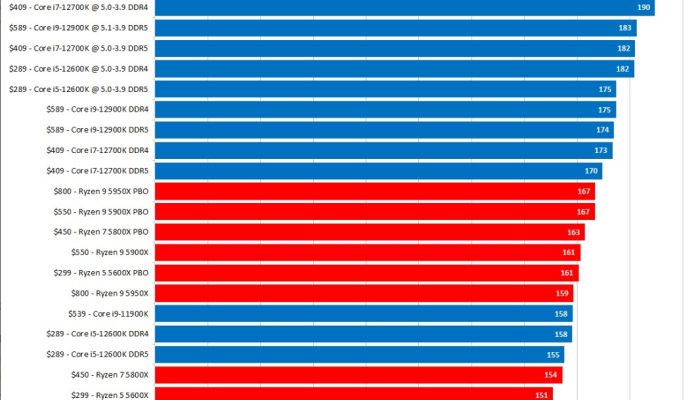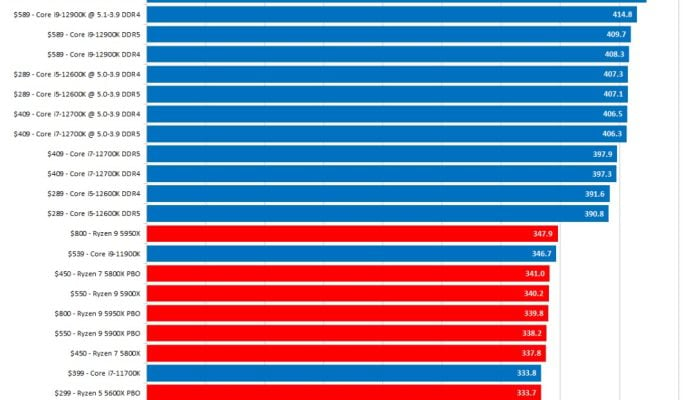When it comes to selecting the ideal CPUs for gaming, workstation tasks, or just one of the best budget CPUs, the options narrow down to two: AMD and Intel. However, this has led to fervent devotion among supporters of each brand, resulting in heated debates that can make it difficult to receive impartial recommendations on which processor is the ideal fit for your needs. Choose the Dedicated Server that suits you best from the options provided by Beehosting https://beehosting.pro/dedicated-servers-rental/.
In this article, we’ll look at and compare AMD and Intel desktop processors, while excluding discussions on laptop or server chips. We evaluate the chips against seven criteria, considering your intended PC usage, cost, performance, driver support, energy consumption, and security. This gives us a clear view of the state of the competition. We will also discuss the architectures and process node factors that influence the moving goalposts. Nevertheless, each brand has its own set of advantages and disadvantages, meaning that the CPU brand you should opt for will mainly hinge on your priorities concerning the combination of features, cost, and performance.
If you’re looking for the fastest chips on the market at an affordable price, you should look into the powerful 13th-generation Intel Raptor Lake series. Raptor Lake is based on Intel’s Hybrid Architecture formula that combines high-performance and efficient cores in one package to provide a winning combination of performance in both gaming and workloads, but this comes at the cost of higher power consumption than competing AMD chips.
AMD’s answer comes in the form of the Ryzen 7000 series based on Zen 4. AMD has recently slashed the prices of their chips and released our new non-X models that lower the starting price, but AM5 motherboards and DDR5 memory are still more expensive, which is muddying the value proposition.
AMD’s powerful Ryzen 7000 “X3D” models use revolutionary 3D chip stacking technology to take the overwhelming lead in gaming performance, as you can see in our Ryzen 7 7800X3D review. This technology results in significant performance reductions in productive applications, so you need to be aware of the trade-offs.
Below you can see how the entire Ryzen 7000 family compares to Raptor Lake in a number of categories that also include benchmarks and pricing.
AMD vs Intel CPUs
Here are the results of our analysis and testing: Intel is 7:5 ahead of AMD on the criteria shown in the table below.
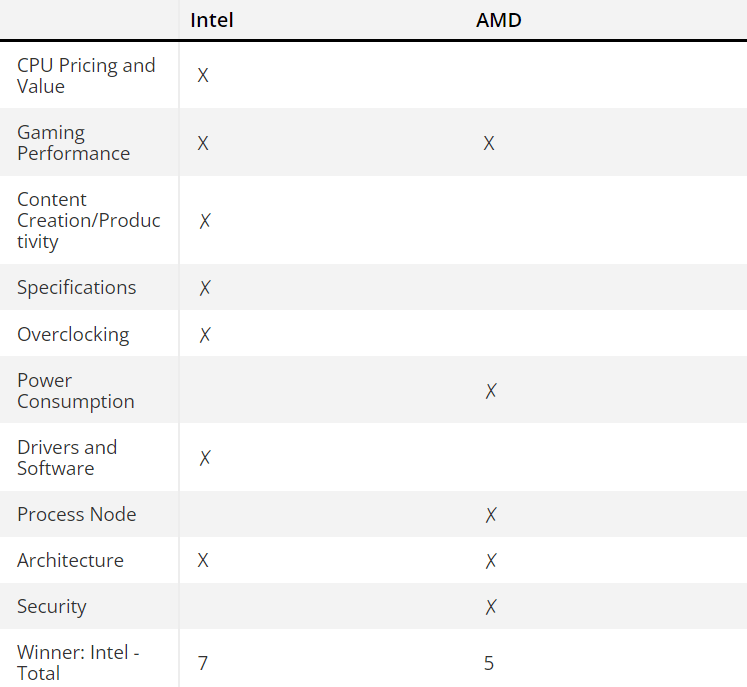
In the following sections, we will detail how we arrived at our conclusions for each category.
AMD vs Intel CPU pricing and value
Pricing is the most important consideration for just about everyone, and AMD tends to be hard to beat in the cost department. However, this has changed. Intel is fully committed to regaining market share because the Intel Raptor Lake chips have performance advantages combined with a very competitive price. Rent Dedicated servers with Intel processors or AMD processors – is the most profitable option.
With the introduction of Intel’s Raptor Lake-S models, the company has expanded its mainstream lineup by adding more cores, threads, and features, without raising the prices for most models compared to the previous generation. Although the Core i5 and lower models do have a gen-on-gen markup, the increased performance justifies the additional cost. Overall, Raptor Lake provides a significant decrease in price-per-core and price-per-thread metrics, enabling Intel to surpass AMD in terms of value in the Core i5, i7, and i9 ranges. Furthermore, Intel’s previous-generation Alder Lake models continue to dominate the Core i3 and lower segments.
AMD used to provide numerous benefits, such as bundled coolers and full overclockability on most models, along with free software that included the innovative Precision Boost Overdrive (PBO) auto-overclocking feature. With aggressive pricing for Ryzen processors, AMD dominated the value segment for several generations. However, the equation began to shift when AMD raised prices considerably and stopped providing bundled coolers with its chips, especially now that it has more stringent cooling requirements than in the past.
Ryzen 7000/5000 vs Intel 13th-Gen Raptor Lake/12th-Gen Alder Lake

AMD continues to provide the flexibility of overclocking on all chip models and nearly all of its motherboards, except for the A-Series motherboards, which is a boon for enthusiasts. In contrast, Intel demands a higher price for its overclockable K-Series chips, and in addition to that, users will need to invest in an expensive Z-Series motherboard to gain access to overclocking capabilities. Intel doesn’t support full overclocking on B- or H-series motherboards, but it has permitted memory overclocking on its B560 and H570 chipsets.
Typically, AMD outperforms Intel in terms of coolers, as the majority of AMD’s provided coolers are appropriate for moderate overclocking, but they have stopped supplying them with any of the ‘X’ models. Similarly, Intel doesn’t offer a cooler with its expensive overclockable K-series SKUs. Therefore, if you intend to overclock an Intel processor, it’s critical to allocate funds for a suitable cooler, and a powerful one at that.
Intel and AMD both provide a bundled cooler with their downstream SKUs, specifically non-K for Intel and non-X for AMD, but Intel’s coolers are flimsy and ‘good enough’ at best. In contrast, AMD’s coolers are sturdy and frequently provide some margin for overclocking. Although Intel has somewhat improved its coolers, the aesthetic and slight thermal improvements aren’t enough to match AMD’s competent coolers, and they aren’t available on all models.
Although the cost of the chip is not the sole determining factor, platform pricing also needs to be taken into consideration. Intel’s Raptor Lake chips utilize the same LGA 1700 interface as the prior-generation Alder Lake chips and the company plans to release one more generation for this platform. With a firmware update, Raptor Lake chips can be used with previous-generation 600-series boards, resulting in potential cost savings, although it’s important to note any potential limitations.
AMD continued to support its AM4 socket for five chip generations. Although the platform will continue to exist for some time with Ryzen 5000 chips offering cost-effective alternatives, AMD’s latest Ryzen 7000 chips are designed to fit into the new AM5 socket. According to AMD, this socket will be supported until 2025 or beyond, which could potentially provide a similarly long upgrade path for enthusiasts as AM4 did.
Intel was the first to adopt PCIe 5.0 and DDR5 technologies, but AMD has also included support for both in its Ryzen 7000 processors. However, DDR5 adds a substantial cost to motherboards, and while Intel allows users to choose between DDR4 and DDR5 memory, AMD only supports the more expensive DDR5. This puts AMD at a significant disadvantage as it does not offer any significant performance benefits. Consequently, AMD’s AM5 platform suffers from high memory and motherboard prices, giving Intel a significant advantage in terms of platform pricing.
In the end, AMD also chose to exit the high-end desktop (HEDT) market segment, which signifies the end of an era. If you want more cores and connectivity, you now have to switch to workstation-class processors from both Intel and AMD. AMD currently dominates the performance tier for the best workstation CPUs, enabling them to charge extremely high premiums, and they do just that. As a result, AMD has removed its least expensive Threadripper models from retail and set an entry price of $2,399.
The winner is Intel. Although AMD CPUs still have a strong performance record across their entire product range, Intel’s Raptor Lake currently offers the best overall value and performance across all price ranges.
However, this disparity not only applies to chip pricing, but the difference becomes significantly wider when we consider the other expenses involved in constructing a PC. While both Intel and AMD offer support for PCIe 5.0 and DDR5, this results in a generation-on-generation increase in motherboard costs. Nevertheless, Intel’s platform also accommodates DDR4, allowing users to avoid both the DDR5 memory and motherboard expenses.
AMD has included new specifications in its motherboards that make them relatively expensive compared to Intel’s 600- and 700-series motherboards, leading to a significant increase in AMD’s platform pricing. This results in more robust lower-tier motherboards, but it gives Intel an advantage in terms of pricing. To address its pricing issues, AMD has introduced its A620 motherboards, but Intel also has a strong lineup of value-focused H-series motherboards.
Intel vs AMD CPU Gaming Performance
When it comes to gaming performance in the AMD vs Intel CPU battle, Intel currently outperforms AMD in all key price ranges. Below, we have compiled a broad range of gaming performance metrics for existing chips across different price brackets. Additionally, we have included two sets of test results below that summarize performance in both Windows 10 and Windows 11, as Intel’s Raptor and Alder Lake offer better performance in Windows 10 than in 11. Nevertheless, Intel is ahead of the competition in both operating systems.
Average FPS(Geomean), Entire Test Suite1080p - Windows 11
Intel’s Raptor Lake chips outperform AMD’s standard Zen 4-powered Ryzen 7000 processors across the board. However, AMD’s new Ryzen 7 7800X3D, Ryzen 9 7950X3D, and Ryzen 9 7900X3D take the overall lead, though that does come with performance tradeoffs in many productivity applications.
Intel’s fastest gaming chips are the Core i9-13900K and Core i9-13900KS, regardless of their high prices. However, the Core i7-13700K delivers similar gaming performance for a significantly lower price, making it the preferred choice for performance addicts. The Core i5-13600K is an excellent choice for mainstream gamers, but the Core i5-13400, priced at around $200, is the benchmark for value. In the approximately $110 price range, the Core i3-12100 is the chip to beat.
AMD’s fastest standard gaming chip is the Ryzen 9 7900X, but its advantage is not significant. The Ryzen 9 7950X and Ryzen 7 7700X deliver comparable gaming performance. The Ryzen 5 7600X has a lower price of $300, but its performance is inferior. However, compared to Intel’s chips, these AMD chips are noticeably slower, especially when considering their pricing. AMD also offers lower-priced alternatives, including the AMD Ryzen 9 7900, Ryzen 7 7700, and Ryzen 5 7600, which can compete with their X-series counterparts after overclocking, resulting in the improved value for AMD.
When you increase your resolution to 1440p or higher, the GPU often becomes the bottleneck, and therefore, you may not see significant benefits from your CPU’s gaming capabilities. However, having slightly better CPU performance can be advantageous if you intend to upgrade your graphics card to a newer generation while maintaining the rest of your system. In the mid-range category, most builds typically come with lower-end GPUs, which usually balance out the CPU performance.
When it comes to integrated graphics performance, AMD is unbeatable. Their latest Cezanne APUs, including the Ryzen 7 5700G and Ryzen 5 5600G, provide the best-integrated graphics performance currently available. Rent Dedicated Server for High Performance from Beehosting.
Result: Tie. Intel’s Raptor Lake chips have taken over the gaming performance lead from AMD’s standard Ryzen 7000 processors in key price ranges. However, if you’re willing to pay a premium, AMD’s new 3D V-Cache models, such as the Ryzen 7 7800X3D, Ryzen 9 7950X3D, and Ryzen 9 7900X3D, offer better performance.
The X3D chips from AMD are unquestionably the speediest available in the market, although they do have some drawbacks when it comes to productivity applications. The Ryzen 7 7800X3D from AMD is an exceptional processor, delivering the ultimate gaming performance, which has earned it a place on our list of top CPUs. However, its price of $449 exceeds the typical sweet spot of $250 to $300 for mainstream gamers.
Intel’s Core i9-13900K is the top choice on the high-end if you’re seeking the optimal combination of performance for both gaming and productivity. However, if you want a chip that provides comparable gaming performance at a lower price point while sacrificing some productivity capabilities, then the Core i7-13700K is the one to go for. For most people, the Core i5-13400F is a perfect choice, as it offers the best balance between price and performance, making it the undisputed best CPU for gaming within its price range.
AMD vs Intel Productivity and Content Performance
In the contest of non-gaming performance between AMD and Intel CPUs, Intel’s Raptor Lake chips have made significant progress against AMD’s top-tier options and provide a better price-to-performance ratio across a broad range of workloads.
Multi Threaded performance ranking Windows 11
In certain workloads related to threaded productivity and content creation, AMD’s highest-end chip comes out on top in terms of ultimate performance, thanks to its abundant cores, threads, and cache featured in the flagship Ryzen 9 7950X. However, these victories come with a much higher price tag, which is not enough to justify the premium.
With Raptor Lake, Intel continues to utilize a combination of two types of cores for mainstream desktop PCs. The significant performance cores (P-cores) are ideal for latency-sensitive tasks, giving Intel a clear advantage in single-threaded applications. The efficiency cores (E-cores) come into play to provide extra power in threaded and background applications, resulting in significant gains in content creation and productivity workloads that heavily rely on heavily-threading. The E-cores have proven to be the unsung hero for Raptor Lake in creativity and productivity workloads, allowing Intel to take the lead from AMD in the most important pricing bands.
Solid single-threaded performance translates to faster speeds in various workloads, especially for everyday applications that require a quick response from the processor. The Raptor Lake Core i9-13900K has established itself as the indisputable leader in single-threaded performance across all our benchmarks, but it’s also the most expensive mainstream CPU offered by Intel. However, if you’re looking for snappy single-threaded performance, the other Raptor Lake processors still outperform their AMD counterparts by a considerable margin. In conclusion, Intel’s Raptor Lake family reigns supreme when it comes to single-threaded performance.
Winner: Intel. When it comes to professionals seeking high performance in content creation and productivity applications, Intel emerges as the winner in the AMD vs. Intel CPUs competition thanks to its x86 hybrid architecture. This groundbreaking design combines two types of cores to create a mighty processor architecture that excels in both single-threaded and threaded workloads.
AMD vs Intel Processor Specifications and Features
AMD’s product lineup includes Ryzen 3, Ryzen 5, Ryzen 7, Ryzen 9, and Threadripper, while Intel breaks up its offerings into Core i3, Core i5, Core i7, Core i9, and Cascade Lake-X families. To simplify the comparison of Intel and AMD CPUs based on specifications and features, we’ll only be focusing on the top chips in each family. It’s worth noting that both companies have more affordable options within each tier, but by examining these (somewhat condensed) lists, we can gain a broad understanding of the market. The prices we’ll be using are both the recommended prices from each vendor and the street prices.
In the past, the high-end desktop (HEDT) market was primarily dominated by creative prosumers who required powerful multi-core processors to fulfill their various needs. Intel was the undisputed leader in this space, but with the introduction of AMD’s Threadripper lineup, Intel was eventually dethroned. AMD’s success effectively forced Intel out of the HEDT market, as they haven’t launched a new HEDT chip since the release of Cascade Lake-X processors back in 2019. Consequently, AMD’s decision to abandon the HEDT market signals the end of the HEDT era, at least for the time being.
AMD vs Intel CPUs HEDT Specs and Pricing
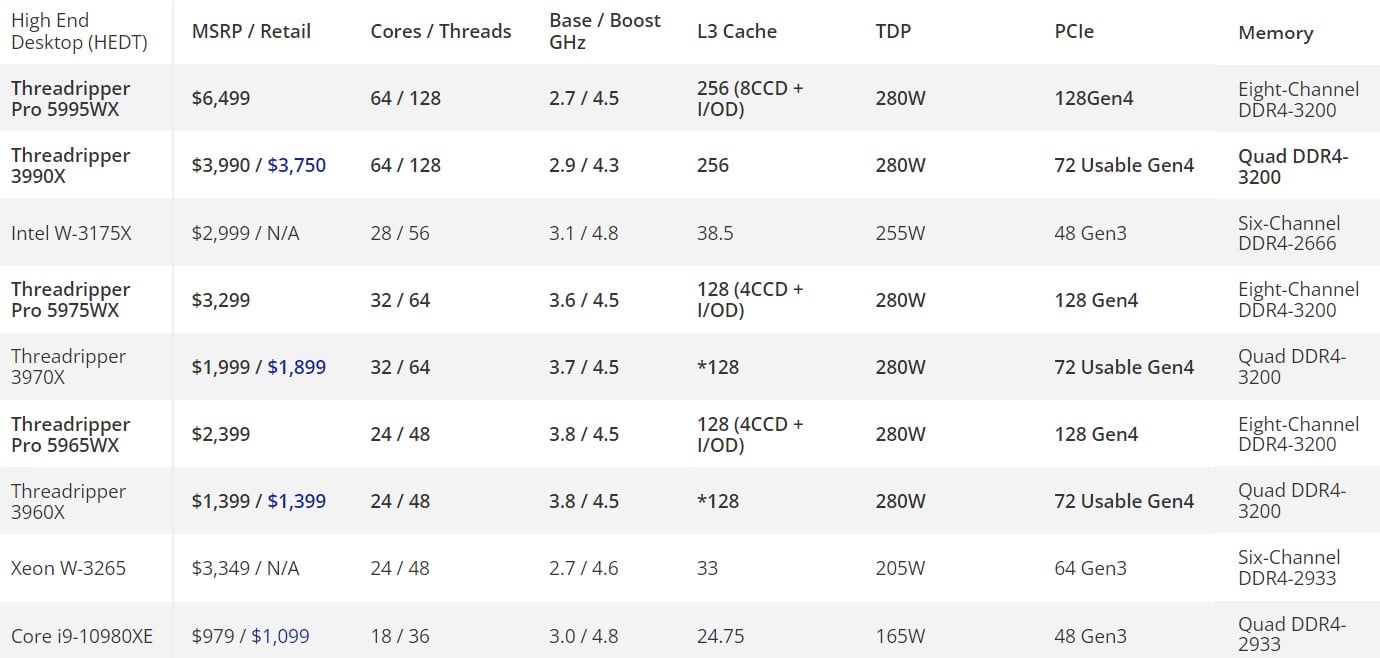
In terms of comparing AMD and Intel HEDT/workstation CPUs, it’s evident that AMD’s ultimate HEDT-exclusive lineup reigns supreme. Their flagship Threadripper 3990X boasts an unmatched 64 cores and 128 threads, while their 32-core and 24-core Threadripper 3970X and 3960X models solidify their substantial lead over Intel’s offerings. Additionally, AMD’s workstation-specific models, the 64-core AMD Threadripper Pro 5995WX, 32-core Threadripper Pro 5975WX, and 24-core Threadripper Pro 5965WX, are geared towards the workstation market.
Intel divides its top-tier product range into two categories, with the Xeon W-3175X and W-3265 designed for exotic LGA3647 motherboards that come with eye-watering price tags to match the chips’ high pricing. However, these systems aren’t really aimed at enthusiasts but rather intended for the professional workstation market.
Intel’s HEDT series came to a close with the release of the 18-core Cascade Lake-X Core i9-10980XE, which was designed to fit into LGA2066 motherboards. That chip was powerful, given its price point, but Threadripper’s 3.5X advantage in core counts was impossible to beat, so Intel ceded the HEDT market to AMD.
AMD’s Threadripper range offers more cores, cache, and faster PCIe 4.0 connectivity, but they do come with higher price tags to match the performance of these powerful processors. However, when we examine the per-core pricing or the cost per CPU core, AMD’s offering becomes more appealing due to its compelling value proposition.
AMD vs Intel High End Specs and Pricing
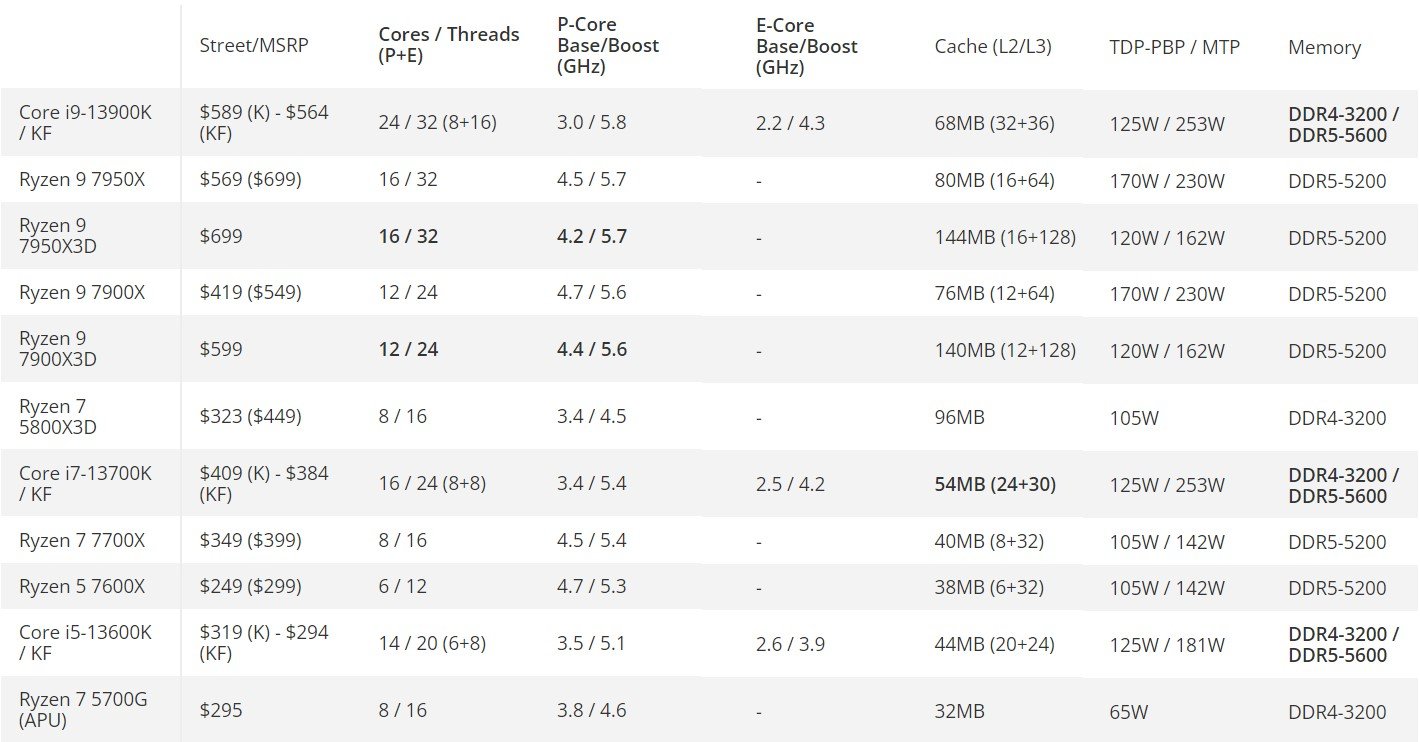
AMD’s Ryzen 9 and Ryzen 7 families compete against Intel’s Core i9 and Core i7 lineup in the high-end CPU battle.
The Ryzen 9 7950X3D and the Ryzen 9 7900X3D are among the fastest gaming chips available, with the former being the undisputed leader. However, they are priced at a premium. The Core i9-13900K, on the other hand, is considered the top-performing processor for gaming, single-threaded, and multi-threaded work. While the Ryzen 9 7950X edges ahead in some specific types of multi-threaded tasks, it falls behind in other areas.
In the more mainstream markets for Ryzen 7 and Core i7 processors, the situation is comparable. Gamers with ample resources should consider these chips, but the Core i5 and Ryzen 5 models in the next category are even more appropriate for their needs. Intel’s Core i7-13700K offers nearly the same gaming performance as the Core i9-13900K in this market segment, but at a significantly lower cost, albeit with some sacrifice in multi-threaded productivity. It also outperforms the similarly priced Ryzen 9 7900X. However, AMD plans to launch its Ryzen 7 7800X3D in the near future, which could be a game-changer for gamers.
AMD Ryzen 7000 Specifications and Pricing

When comparing mid-range and budget CPUs from AMD and Intel, the Ryzen 5 and Ryzen 3 processors are pitted against the Core i5 and i3 families. This particular market segment represents a significant portion of the sales for both companies, making pricing and value crucial factors. While Intel and AMD have recently introduced their latest architectures, Raptor Lake and Ryzen 7000, only the high-end models in each category were included in the initial release. As a result, some of the lower-end models in the Ryzen 5 and Core i5 categories, as well as all Core i3 and Ryzen 3 models, belong to previous generations.
The Core i5-13600K provides class-leading performance in gaming, single- and multi-threaded applications at the $300 price range, while Intel’s Core i5-13400 leads the ~$200 price range.
AMD and Intel Low-End Specs and Pricing

To compete with Intel’s lower-end chips, AMD relies on its previous-generation Zen 2 APUs, such as the Ryzen 5 4600G. However, when it comes to gaming chips under $200, Intel surpasses AMD by a significant margin. Nevertheless, AMD’s APUs are equipped with powerful Vega graphics units that allow for low-end gaming across a wide range of titles. Intel’s chips cannot compare in this regard, and if you intend to engage in any significant gaming with the Intel options, you will need a discrete GPU.
Intel offers an integrated GPU (iGPU) with all of its SKUs, but it also provides its F-Series chips without graphics at a reduced cost. In a first for its mainstream Ryzen models, AMD has included an RDNA 2 iGPU in its Ryzen 7000 chips. However, as the iGPU found in Intel’s chips, these graphics units are not suitable for gaming. To achieve gaming capabilities from a desktop CPU, you will need to select an APU.
Winner: Intel. Upon comparing the CPU specifications of AMD and Intel, it becomes apparent that Intel provides options with superior performance at a lower cost. Another advantage of Intel’s chips is their compatibility with DDR4, which is particularly significant during the early stages of DDR5 adoption.
AMD vs Intel CPU Power Consumption and Heat
In terms of CPU power and heat, the 7nm process node utilized by AMD has a significant impact. Power consumption is a result of design decisions such as lithography and architecture, which we will explore in more detail below. However, chips with higher power consumption typically generate more heat, necessitating the use of more robust coolers to counteract the heat produced by such power-hungry CPUs.
In general, Intel has managed to lower its power consumption from a level that was once a subject of memes to a satisfactory point, but it still utilizes more power compared to Ryzen. Nonetheless, due to its significantly higher speed, Raptor Lake has garnered some leniency.
In the past, Intel gained a reputation for consuming excessive amounts of power due to difficulties with its 14nm process. However, with its most recent two generations, the situation has improved. With the introduction of the ‘Intel 7’ process, coupled with the x86 hybrid architecture, significant enhancements have been made to Intel’s power efficiency and performance metrics.
Although the Intel Raptor Lake chips still consume more power than AMD’s Ryzen 7000 series chips, combining the Intel 7 process with the hybrid architecture results in substantial enhancements, especially in threaded work.
Overall, AMD’s 5nm chips either consume less power or offer significantly superior power-to-performance efficiency. This means that you can accomplish more work per unit of energy consumed, which is a win-win, and AMD’s cooling demands are not nearly as excessive. Try Dedicated AMD Ryzen Server from Beehosting.
Winner: AMD. When evaluating the performance per watt of AMD versus Intel CPUs, it is crucial to emphasize the significance of combining the most compact process node with a proficient microarchitecture, and TSMC’s 5nm technology and AMD’s Zen 4 architecture are the ideal matches. The most recent Ryzen CPUs outperform Intel in terms of power efficiency and performance.
Intel vs AMD CPU Overlocking
There is no question that Intel has an advantage when it comes to CPU overclocking compared to AMD. Intel CPUs provide more headroom for overclocking, which means that you can achieve a greater performance boost beyond the baseline speed than you can with AMD’s Ryzen processors.
Above you can see that in chart form, and here’s that same data in table form, showing that Intel’s Alder Lake offers far more overclocking headroom than Ryzen 5000:
Alder Lake vs Ryzen 5000 Overclock Uplift – Stock configuration used as a baseline – Windows 11

As previously stated, to fully utilize Intel’s overclocking capabilities, you will need to invest in a high-end K-Series CPU, a costly Z-Series motherboard, and a capable aftermarket cooler, preferably liquid-cooled. Despite the additional expenses, Intel’s chips are relatively simple to push to their limits, with the 13th-Gen Raptor Lake processors reaching a peak of 6.0 to 6.2 GHz.
While Intel does not permit complete overclocking on B- or H-series motherboards, it has integrated memory overclocking into its B560 and H570 chipsets, which works with any chip compatible with the platform. That can provide a big boost to locked chips, like the Core i5-13400 we recently reviewed.
AMD’s chips don’t offer much scope for manual tuning, and their maximum all-core overclocks are typically a few hundred MHz lower than the maximum single-core boost. This implies that all-core overclocking may lead to a slight reduction in performance in lightly-threaded applications.
AMD’s chips show differences in core boosting due to a technique called binning, which allows some cores to achieve higher speeds than others. Additionally, AMD uses a thread-targeting technique in combination with Precision Boost, which assigns lightly-threaded tasks to the fastest cores, allowing the chips to perform at near-overclocked levels without manual tuning. As a result, there is less room for further overclocking.
Despite the limited overclocking headroom, AMD provides an easy and efficient way to enhance chip performance through Precision Boost Overdrive, an auto-overclocking feature that adjusts based on the chip’s capabilities, motherboard power delivery, and CPU cooling with a single click. While it still falls short of Intel’s high frequencies, this approach ensures optimal performance with minimal hassle. Moreover, with the Ryzen 7000 series, AMD has significantly improved its memory overclocking capabilities.
Winner: Intel. In terms of CPU overclocking between AMD and Intel, Intel’s K-series processors offer significantly greater headroom and the ability to reach much higher frequencies. However, it’s important to note that this privilege comes at a cost. On the other hand, Intel has made strides by incorporating memory overclocking into their latest B- and H-series motherboards.
AMD’s strategy is more user-friendly for those who are new to overclocking, providing them with a hassle-free experience based on their system’s capabilities. However, the trade-off is that the performance gains are not as significant compared to other approaches.
AMD VS Intel CPU Lithography
Several key technologies determine the overall power and capability of a chip. As a basic principle, the processor with the densest process nodes, along with decent power, performance, and area (PPA) characteristics, will typically come out on top if combined with a solid microarchitecture. If we evaluate AMD versus Intel CPUs using these criteria, AMD currently has an advantage in terms of lithography.
The question of whether AMD truly holds the advantage in lithography is up for discussion, as AMD doesn’t manufacture its own processors as Intel does. Instead, AMD designs its processors and outsources its production to external fabs. In the case of AMD’s latest Ryzen processors, the company relies on a blend of TSMC’s 6nm and 5nm process nodes, with the latter being the more crucial one.
TSMC’s 5nm process node is employed by major tech companies such as Apple and Nvidia, as well as numerous others, which allows it to benefit from industry-wide investment and cooperative development efforts. On the other hand, Intel has stated that it won’t reclaim the top spot in process technology until it introduces its Intel 20A node in the year 2024.
By utilizing TSMC’s 5nm process node, AMD is able to design more compact chips with a higher number of performance cores while maintaining a relatively low power consumption. Nevertheless, the economics of semiconductor manufacturing suggest that the cost per transistor increases as we transition to smaller process nodes, resulting in higher production costs for 5nm chips compared to previous generations.
Intel has experienced a bit of a resurgence with its latest Alder and Raptor Lake lineups, which are produced using the ‘Intel 7’ process node. This marks the end of a six-year struggle with the 14nm process node, which ultimately resulted in Intel losing its performance advantage over AMD in the desktop PC market. Previously known as 10nm Enhanced SuperFin, Intel has recently renamed its process nodes to conform with industry standards.
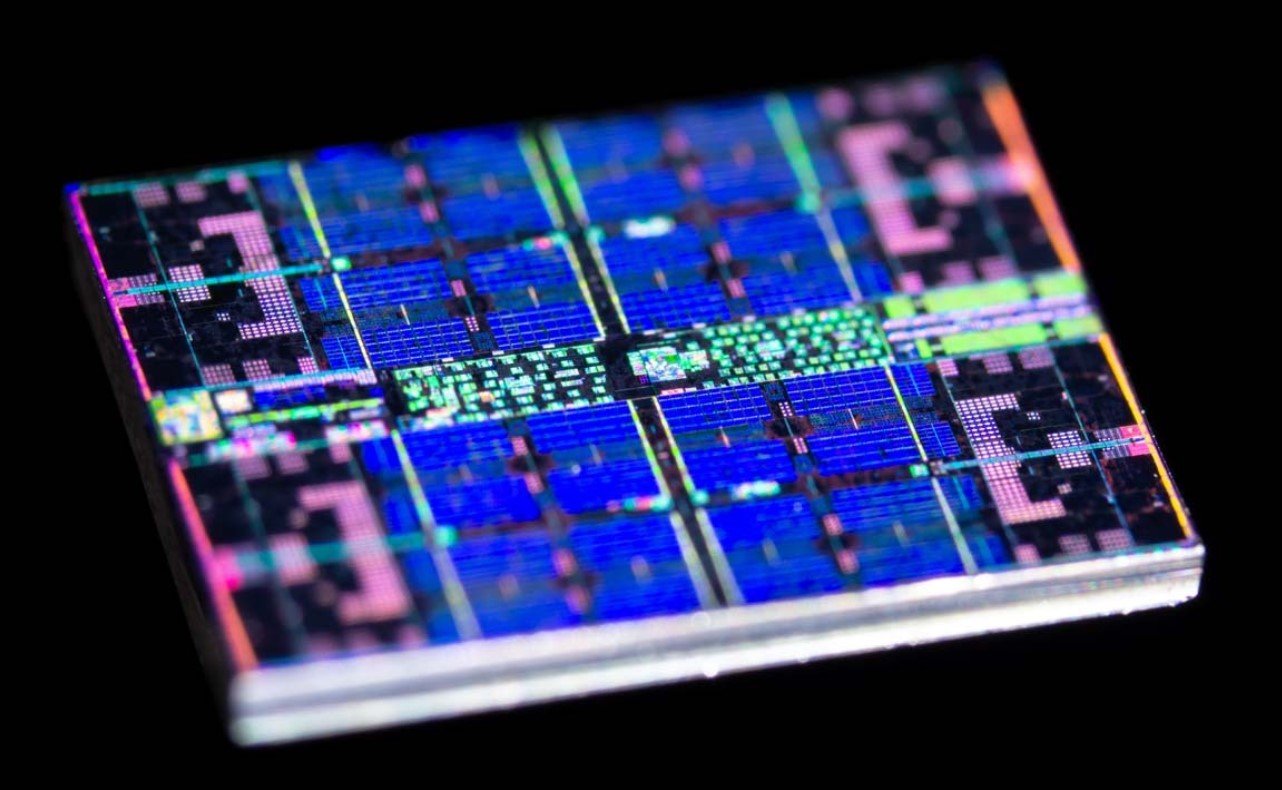
With the adoption of the ‘Intel 7’ process node, Intel has significantly narrowed the gap with AMD in terms of process technology. Although Raptor Lake CPUs still consume more power than AMD’s Ryzen 7000 series chips, the Intel 7 process represents a significant improvement. In general, Raptor Lake CPUs boast significantly enhanced power efficiency metrics.
Winner: AMD (TSMC). While the adoption of the ‘Intel 7’ process node has brought Intel closer to AMD in terms of process technology than it has been in recent years, AMD still maintains its lead in overall power efficiency and transistor density thanks to the benefits of TSMC’s 5nm process.
Intel vs AMD CPU Architecture
Two key design decisions that significantly impact performance, scalability, and performance-per-dollar in a comparison of AMD versus Intel CPUs are interconnected and microarchitecture.
AMD’s use of Infinity Fabric enables the integration of multiple dies into a single cohesive processor, akin to assembling many small puzzle pieces to form a larger picture. This approach enables the use of multiple small dies instead of one large die, improving yields and reducing costs. Furthermore, it offers a level of scalability that Intel may struggle to match with its new mesh interconnect in its HEDT chips and outperforms Intel’s aging ring bus architecture in desktop processors.
AMD initially combined its Infinity Fabric advantage with its Zen microarchitecture, which was designed with scalability in mind. This resulted in a remarkable 52% increase in instructions per clock (IPC) throughput over AMD’s previous-generation ‘Bulldozer’ chips. The Zen 2 microarchitecture further improved IPC by 15%. When paired with the 7nm process, AMD achieved up to 31% per-core performance improvement, which is a combination of frequency and IPC. With Zen 3, AMD achieved its largest single leap forward in the post-Bulldozer era with a 19% jump in IPC. Zen 4, coupled with the 5nm node, achieved a comparable 14% improvement. AMD RYZEN Dedicated Servers from Beehosting is the best choice.
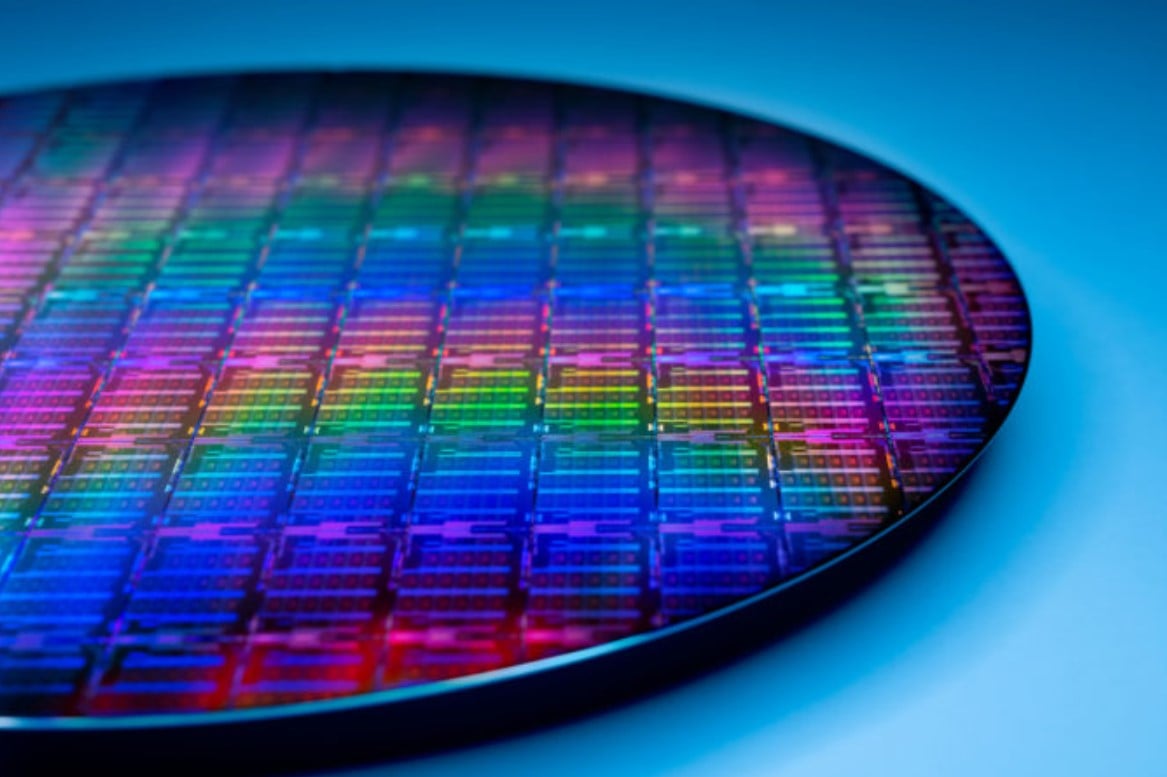
Intel’s latest desktop processors, the 13th-gen Alder Lake, and 13th-gen Raptor Lake, feature a new hybrid x86 architecture that combines larger high-performance cores with smaller high-efficiency cores. This is the first time this architecture has been used in desktop x86 PCs by Intel. The high-performance cores are powered by the Golden Cove architecture, while the high-efficiency cores are based on the Gracemont architecture. These chips are built using Intel’s ‘Intel 7’ process, which is the company’s first new node for the desktop market since the debut of the 14nm node six years ago.
Intel’s Alder Lake has achieved significant performance gains, thanks to the new Thread Director technology. However, it requires an operating system and applications that are aware of the chip’s hybrid design, which utilizes both faster and slower cores that are optimized for different voltage/frequency profiles. To achieve maximum performance and efficiency, workloads (threads) need to be assigned to the appropriate core based on the type of application being run.
In general, Intel’s x86 hybrid architecture has been highly successful, achieving top-notch gaming performance and excelling in both single-threaded and multi-threaded workloads in regular applications. However, although the hybrid x86 architecture has similar roots to Arm’s big.LITTLE designs, it does not have the same focus on power efficiency. Intel prioritizes performance above everything else, so in most cases, AMD still maintains the lead in power efficiency.
When evaluating CPU architecture between AMD and Intel, it’s evident that the competition has significantly tightened compared to the past few years. AMD’s Zen 4 architecture is an impressive feat, enabling advanced scalability and enhanced power efficiency through its efficiency-focused design, coupled with TSMC’s 5nm node technology.
On the flip side, Intel’s Raptor Lake architecture is impressive in its own way, being the first to introduce a combination of small efficient cores and large performance cores to x86 desktop PCs. This gives it an edge in performance, but it still lags behind in terms of power efficiency, resulting in a draw in this aspect.
Intel VS AMD CPU Drivers and Software
When comparing the software support of AMD and Intel CPUs, Intel has a stronger reputation. AMD has faced many problems with its CPU and chipset drivers, which is understandable given its limited resources compared to its much larger competitors. While Intel has also had some issues with its drivers, its stable reputation has helped it maintain its position as the leader in the processor market, especially among OEMs.
When considering Intel’s unconventional solutions, it’s advisable to exercise some caution. Historically, the company has introduced innovative products that ended up being discontinued due to pricing and market challenges, and the long-term support for such products may not always be straightforward.
AMD still faces challenges as a smaller competitor. The company has had trouble with BIOS releases in the past that did not fully unlock the performance of its chips, although it has mostly resolved those issues with a series of updates. Additionally, as a result of the industry’s focus on optimizing for Intel’s architectures above all others, AMD faces the daunting task of trying to compete.
Challenging the semiconductor industry is no easy feat, especially when you’re competing against a larger and more established rival. In the process of redefining the industry, things can break. For AMD, these broken things include operating systems and applications that weren’t optimized to fully utilize the performance potential of its first-generation Zen architecture, let alone the core-heavy designs of Zen 3. Even with multi-CCD Zen 4 models, we still observe some gaming disparities resulting from those earlier challenges. However, most of these issues have been addressed over time.
Intel is not without its own set of challenges. Its Alder Lake architecture is a hybrid x86 design that utilizes larger high-performance cores (P-cores) and smaller high-efficiency cores (E-cores) for specific tasks. To ensure optimal performance, the workloads must be placed on the appropriate cores using Intel’s Thread Director technology. However, this technology is only available on Windows 11, which means that some programs may require additional configuration on Windows 10 to achieve the best possible performance.
Intel emerges as the victor in the CPU driver and software showdown against AMD. In the past year, Intel has made strides in improving its sluggish driver updates for integrated graphics, and benefits from a robust team of software developers who prioritize timely support for their products with the latest software. While AMD has successfully convinced the developer community to optimize for its new Zen architectures, there is still room for improvement as the company looks to the future.
AMD vs Intel CPU Security
In recent years, security researchers have been delving into the speculative execution engine, a crucial feature that enhances the performance of modern chips. This research has led to the discovery of countless new vulnerabilities, posing a constant threat to the safety of both your system and private data. What makes these vulnerabilities particularly dangerous is their undetectable nature, as they exploit the processor in the way it was designed, rendering them invisible to all known anti-virus programs. Beehosting offers Hight-secured Dedicated servers in Germany, Dedicated servers in USA, and Dedicated servers in Finland.
The number of necessary patches to cover up these vulnerabilities keeps increasing, and a lot of them cause a decrease in performance. This is especially problematic for Intel as it experiences a higher number of these vulnerabilities compared to other manufacturers. Although the company has come up with in-silicon mitigations in newer processors that can lessen or remove the performance overhead, older processors may still experience significant performance reductions.
Intel is facing yet another wave of Spectre v2-variant attacks, which have further diminished its performance. These fresh vulnerabilities, known as Spectre Branch History Injection (BHI), can cause significant performance degradation that varies depending on the type of workload.
Although AMD is not invulnerable to vulnerabilities, it is difficult to determine whether the limited number of vulnerabilities discovered in AMD processors was due to a security-first approach to designing hardened processors, or if it was simply because researchers and attackers primarily targeted Intel processors due to their dominant market share. Attackers tend to focus on the most widespread targets, which is evident in the higher frequency of malware designed for Windows systems, the most commonly used desktop OS, compared to MacOS, although this trend seems to be shifting.
During the investigation of the latest Spectre vulnerabilities, Intel found that AMD’s current Spectre mitigation was ineffective, prompting AMD to adopt a different, albeit slower approach to tackle the problem.
Nonetheless, AMD has faced several other vulnerability disclosures in the recent past, including a variant similar to Meltdown that requires software to be recorded. Like Intel, AMD has made a few targeted in-silicon fixes for its Ryzen 5000 processors, thus lowering its exposure to vulnerabilities.
Winner: AMD. As security researchers and malicious actors increasingly scrutinize AMD’s latest architectures, the debate over CPU security between AMD and Intel is continuously evolving. At present, Intel still has more identified vulnerabilities than AMD, and the Spectre mitigations on older Intel processors have a more significant impact on performance, resulting in more substantial losses (equivalent to several generations of improvement) compared to the solutions provided by AMD. Consequently, Team Red is declared the winner.
Conclusion
Currently, Intel offers the best combination of performance and overall value at an affordable price. AMD’s onslaught with its Zen-based processors changed our expectations for both the mainstream desktop and HEDT markets, initially taking Intel by surprise as it stuck with 14nm and Skylake architectures. Over the past few years, AMD processors have moved from cost-effective and power-hungry chips to designs that provide more cores, higher performance, and lower power requirements.
In response, Intel has been slow to add features and cores to its product stack, resulting in negative side effects such as increased power consumption and heat dissipation. This only highlighted the company’s difficulties in design and manufacturing.
The AMD vs. Intel ratio has shifted recently as Intel has taken the lead in overall performance, undermining AMD’s price/performance ratio with Raptor Lake chips. Raptor Lake comes with the most disruptive change to Intel’s CPU overall chip design methodology, not to mention core architectures, that we’ve seen in a decade. They also come with Intel 7 process technology, which has proven to be exceptionally competitive, especially when compared to TSMC’s excellent 5nm AMD process node. This changed our rating from 7:4 in favor of AMD to 7:5 in favor of Intel.
Despite facing tough competition, AMD is not backing down. The latest addition to their product line is the Ryzen 7000 X3D chips, built on the 5nm process and equipped with second-generation 3D V-Cache technology. This has resulted in significant improvements in gaming performance, allowing AMD to take the lead in terms of sheer gaming performance. However, this gain in performance comes at a cost, with the Ryzen 7000 X3D chips being priced higher and performing less efficiently in productivity applications. For customers seeking a more balanced performance, AMD offers its standard Ryzen 7000 lineup. Nonetheless, the standard models cannot match the performance and value offered by Raptor Lake.
Intel was the first to adopt PCIe 5.0 and DDR5 technologies, but now AMD has also incorporated both of these in its Ryzen 7000 processors. However, the use of DDR5 memory increases the cost of motherboards significantly, and while Intel offers the option of selecting either DDR4 or DDR5 memory, AMD only supports DDR5 memory. This puts AMD at a significant disadvantage as DDR5 memory does not provide any significant performance improvements. On the other hand, Intel continues with its strict segmentation policies, which restrict features like overclockability, to more expensive chips and motherboards.
Intel’s chips are currently leading in terms of overclockability, for both core and memory frequencies, by a significant margin. Investing in a Z-series motherboard will provide you with significantly more headroom for overclocking than what you would get with the Ryzen 7000 chips.
Despite AMD’s recent updates, Intel is currently winning the CPU battle overall. However, the choice of a processor depends on individual needs. For instance, if power consumption is your top priority or you prefer forward compatibility with your motherboard for several more generations of chips, then an AMD processor may be the better choice. Nevertheless, if you desire the best performance in gaming or applications, overclocking capabilities, or software support, then Team Blue is currently the deserving option for your investment.
Choose the Server option that suits you best from the options provided by Beehosting https://beehosting.pro/dedicated-servers-rental/.




